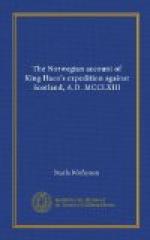The Norwegians on the hill, apprehensive of being surrounded, began to retire in scattered parties towards the sea. Andrew Nicolson, observing this, came up to the rising ground, and desired Ogmund to draw off his men towards the beach, but not to retreat so precipitately as if he fled. The Scotch at this time attacked them furiously with darts and stones. Showers of weapons were poured upon the Norwegians, who defended themselves, and retired in good order. But when they approached the sea, each one hurrying faster than another, those on the beach imagined they were routed. Some therefore leaped into their boats, and pushed off from the land, others jumped into the transport. Their companions called upon them to return, and some returned, tho’ few. Andrew Pott leaped over two boats, and into a third, and so escaped from land. Many boats went down, and some men were lost, and the rest of the Norwegians at last wheeled about towards the sea.
Here Haco of Steini, one of King Haco’s household, fell. The Norwegians were then driven south from the transport, and were headed by Andrew Nicolson, Ogmund Kraekidants, Thorlaug Bosi, and Paul Soor. There soon began a severe contest, tho’ very unequal, as ten Scots fought against each Norwegian. Among the Scotch there was a young knight called Ferash,[89] equally distinguished for his birth and fortune. He wore a helmet plaited with gold, and set with precious stones, and the rest of his armour was of a piece with it. He rode gallantly up to the Norwegians, but no other ventured. He galloped frequently along the Norwegian line, and then back to his own followers. Andrew Nicolson had now reached the Scottish van. He encountered this illustrious knight, and struck at his thigh with such force that he cut it off,[90] through the armour, with his sword, which penetrated to the saddle. The Norwegians stript him of his beautiful belt.[91] The hardest conflict then commenced. Many fell on both sides, but more of the Scotch, as Sturlas sings.
18.
Where cuirasses rung, our generous youths, formed in a circle, prostrated the illustrious givers of bracelets. The birds of prey were gluttonously filled with lifeless limbs. What great chieftain shall avenge the fate of the renowned wearer of the Belt?
During the battle there was so great a tempest that King Haco saw no possibility of bringing the army ashore. Ronald, and Eilif of Naustadale, however, with some men, rowed to land, and greatly distinguished themselves; as did those troops who had before gone out in their boats. Ronald, in the end, was repulsed to his ships; but Eilif behaved most heroically. The Norwegians now began to form themselves anew; and the Scotch took possession of the rising ground. There were continued skirmishes with stones and missile weapons; but towards evening the Norwegians made a desperate charge against the Scotch on the hill, as is here recorded.




